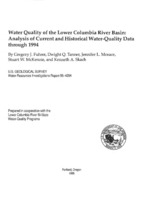Water quality of the lower Columbia River Basin: Analysis of current and historical water-quality data through 1994
Links
- Document: Report (pdf)
- NGMDB Index Page: National Geologic Map Database Index Page
- Download citation as: RIS | Dublin Core
Abstract
The lower Columbia River Basin includes the river basins draining into the Columbia River below Bonneville Dam—the largest of which is the Willamette River. This report presents the results of a study by the U.S. Geological Survey, done in cooperation with the Lower Columbia River Bi-State Water- Quality Program, to describe the water-quality conditions in the lower Columbia River Basin by interpreting historical data collected and data collected in 1994. Historical water-quality data spanning more than 50 years and comprising more than 200 parameters were collated for interpretation in this report. The U.S. Geological Survey, the Oregon Department of Environmental Quality, and the Washington Department of Ecology collected water-quality data at 10 sites in the lower Columbia River Basin from January to December of 1994. Water-quality constituents measured in 1994 were screened against U.S. Environmental Protection Agency (EPA) and State guidelines.
Arsenic, a human carcinogen, was detected in 15 of 16 samples in the lower Columbia River, but was not detected in any of the sampled tributaries. All 15 arsenic detections had concentrations that exceeded both the EPA ambient water-quality criteria for the protection of human health and the EPA human-health advisories for drinking water. Chromium was detected at all four Columbia River sites—most frequently in the Columbia River at Hayden Island. None of the chromium concentrations detected, however, exceeded water-quality criteria or guidelines.
Measurements of suspended trace-element concentrations (trace-element concentrations associated with the suspended-sediment fraction) showed that the suspended form is the dominant transport phase for aluminum, iron, and manganese, whereas the dissolved form is the dominant transport phase for arsenic, barium, chromium, and copper. On the basis of tributary loads during summer low-flow months, sources of suspended silver, nickel, aluminum, and antimony exist in the lower Columbia River Basin, whereas the sources of suspended zinc and arsenic exist outside of the lower basin.
Twenty organic compounds were detected of the 47 compounds analyzed for this study. None of the organic compounds measured exceeded EPA’s ambient water-quality criteria or drinking-water guidelines. The Willamette River at Portland had the largest number of detections, and all 20 compounds were detected at one time or another at that site. The largest concentrations of the agricultural pesticides, atrazine, metolachlor, and simazine were detected in the Willamette River, where they were detected in 93, 86, 93 percent, respectively, of the samples collected. The highest concentrations of atrazine in the Willamette River were associated with the spring application and fall runoff periods.
Both historical and current data showed that the highest water temperatures in the lower Columbia River Basin are present during August. For water years 1977–81 in the Columbia River at Bradwood (river mile 38.9), 75 percent of the daily mean water temperatures during August exceeded 20 degrees Celsius, a “special condition” criterion for the State of Washington. The special condition criterion was exceeded at four sites on the lower Columbia River during July and August, 1994—a period coinciding with season-high air temperatures and low streamflow. Trend tests using data from 1974 to 1994 showed significant (r < 0.05) upward trends for water temperature at the Columbia River at Warrendale and the Willamette River at Portland.
Concentrations of dissolved oxygen and total dissolved gas were above saturation levels during high stormflows in the lower Columbia River and the Willamette River during 1994. The high concentrations of total dissolved gas in the Columbia River exceeded Oregon and Washington State standards of 110 percent of saturation and were caused by spilling water at the Columbia River dams. Aquatic life in the lower Columbia River Basin was not subjected to low dissolved-oxygen concentrations. Comparison of dissolved-oxygen concentrations in the Willamette River from 1949–58 to 1972–94 showed a significant increase in dissolved-oxygen concentrations during the low-streamflow months of summer.
Trend tests showed significant (r < 0.05) downward trends from 1973 to 1994 for three constituents at the Columbia River at Warrendale: phosphorus in unfiltered water, total dissolved solids, and specific conductance. These trends may be a consequence of more conservative agricultural practices in the area upstream from Warrendale.
Study Area
| Publication type | Report |
|---|---|
| Publication Subtype | USGS Numbered Series |
| Title | Water quality of the lower Columbia River Basin: Analysis of current and historical water-quality data through 1994 |
| Series title | Water-Resources Investigations Report |
| Series number | 95-4294 |
| DOI | 10.3133/wri954294 |
| Year Published | 1996 |
| Language | English |
| Publisher | U.S. Geological Survey |
| Publisher location | Portland, OR |
| Contributing office(s) | Oregon Water Science Center |
| Description | x, 157 p. |
| Country | United States |
| State | Oregon |
| Other Geospatial | Columbia River Basin |
| Online Only (Y/N) | N |
| Additional Online Files (Y/N) | N |
| Google Analytic Metrics | Metrics page |


